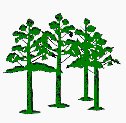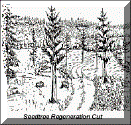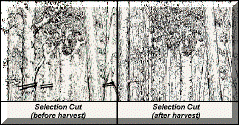
FOREST MANAGEMENT
GUIDELINES FOR MICHIGAN
By the Michigan Society of American Foresters
SILVICULTURAL SYSTEMS
Silviculture is the art and science of tending and regenerating forest vegetation. A silvicultural system is a program of procedures or treatments that includes all of the management functions which meet the landowner's present and long-range objectives. It sets the stage for the next regeneration cut. Silvicultural prescriptions may include harvesting to promote growth, quality, or regeneration of a timber stand. Prescriptions may also recommend conversion to other timber or vegetation types or they may recommend not treatment be made.
 The
proper choice of silvicultural treatments depends on the interaction of timber
types, forest conditions, forest wildlife, and the landowner's objectives. Biodiversity
should be included in the choice of treatments and the manner in which they
are carried out. The landowner must develop an understanding of how a particular
ownership affects the surrounding landscape and other ownerships. A professional
forester can decide which silvicultural system and Best Management Practices
for water quality protection are best suited for a forest stand. It is important
to distinguish between the forester and the logger. The forester is responsible
for designing the forest plan, selecting the silvicultural system, planning
for regeneration, determining the need for intermediate treatments, and arranging
for the harvest. The logger is the person who does the harvesting of the trees
in accord with the prescriptions developed by the forester.
The
proper choice of silvicultural treatments depends on the interaction of timber
types, forest conditions, forest wildlife, and the landowner's objectives. Biodiversity
should be included in the choice of treatments and the manner in which they
are carried out. The landowner must develop an understanding of how a particular
ownership affects the surrounding landscape and other ownerships. A professional
forester can decide which silvicultural system and Best Management Practices
for water quality protection are best suited for a forest stand. It is important
to distinguish between the forester and the logger. The forester is responsible
for designing the forest plan, selecting the silvicultural system, planning
for regeneration, determining the need for intermediate treatments, and arranging
for the harvest. The logger is the person who does the harvesting of the trees
in accord with the prescriptions developed by the forester.
There are two basic silvicultural systems used in Michigan for management and regeneration of timber stands. They are the even-aged and the uneven-aged systems. The choice depends on the ecology of the tree species and on the landowner's objectives for wildlife, aesthetics, wood products, and income. The use of special reforestation techniques may be necessary to regenerate yellow birch, hemlock, jack pine, cedar, and oak for commercial reasons and to ensure ecological diversity of plant communities. These include in these are site preparation techniques to reduce competition and to prepare a mineral soil seedbed. Mechanical scarification, controlled fire, and herbicides are common site preparation methods. Under the even-aged system, stands consist of trees of the same, or nearly the same, age. By contrast, under the uneven-aged system, stands include at least three different age classes and size classes.
The even-aged system includes three regeneration cutting methods:
Clearcutting
Seedtree
Shelterwood
Clearcutting is the most common regeneration cutting method associated with even-aged management of sun-loving species. In this method, an entire stand is removed in one cut. Aspen regenerates extremely well under the clearcutting method. It is permissible and often of great value to retain small patches or a few scattered individuals of tree species for aesthetics, wildlife, and biodiversity. Many applications of the method are enhanced with site preparation and planting or seeding. In some cases, regeneration of a more shade-tolerant species may already be present. This presents some options in determining the composition of the developing new stand.
 In
the seedtree method, nearly all of the old stand is removed
in one cutting, except for a number of trees which are left to provide seed
for regeneration. Seed trees may be left singly, in small groups, or in narrow
strips. The seed trees do not provide enough cover to have any significant sheltering
effect on the regeneration. This distinguishes the seedtree method from the
shelterwood method. Use of seed trees is largely limited to light-seeded, sun-loving
species because the seed must be spread by the wind. Use of the seedtree method
is also limited by the vulnerability of isolated trees to windthrow. The method
is seldom used in the Michigan forest.
In
the seedtree method, nearly all of the old stand is removed
in one cutting, except for a number of trees which are left to provide seed
for regeneration. Seed trees may be left singly, in small groups, or in narrow
strips. The seed trees do not provide enough cover to have any significant sheltering
effect on the regeneration. This distinguishes the seedtree method from the
shelterwood method. Use of seed trees is largely limited to light-seeded, sun-loving
species because the seed must be spread by the wind. Use of the seedtree method
is also limited by the vulnerability of isolated trees to windthrow. The method
is seldom used in the Michigan forest.
 Shelterwood
regeneration is the most complicated of the even-aged systems. This
method regenerates a new stand under the cover of a partial canopy called a
shelterwood. The benefit of a shelterwood to young trees may result from better
growth in partial shade or from protection of the regeneration and developing
stand from insects, diseases, and frost. This system is generally used for heavy-seeded
species or species with seedlings that thrive in light to moderate shade. Once
the shelterwood has served its purpose, it is removed. The shelterwood method
may involve as many as three different cuttings resulting in an even-aged stand.
Under this method, regeneration grows naturally from seed.
Shelterwood
regeneration is the most complicated of the even-aged systems. This
method regenerates a new stand under the cover of a partial canopy called a
shelterwood. The benefit of a shelterwood to young trees may result from better
growth in partial shade or from protection of the regeneration and developing
stand from insects, diseases, and frost. This system is generally used for heavy-seeded
species or species with seedlings that thrive in light to moderate shade. Once
the shelterwood has served its purpose, it is removed. The shelterwood method
may involve as many as three different cuttings resulting in an even-aged stand.
Under this method, regeneration grows naturally from seed.
Several intermediate treatments (operations carried out before final harvest) may be desirable in even-aged silvicultural systems. Early thinning and release are silvicultural treatments applied to young stands to give the best trees more growing space and reduce the time needed to grow a better wood crop. However, often these treatments cost the landowner to complete and are not always performed, despite their silvicultural benefit to the young forest.
On the other hand, commercial thinning (the removal and sale of merchantable trees) is highly beneficial. In Michigan commercial thinning of red pine and northern hardwoods should be performed whenever young stands are too dense and there are enough marketable surplus trees to make the operation pay. Thinning to proper densities by removing poorer quality tree stems and non-commercial timber species frees the best trees from competition and allows them to grow vigorously.
Pruning is the removal of living and dead limbs from the main stem of crop trees. Proper pruning improves stemwood quality and can also improve the aesthetics of the forest. Pruning is a good investment when knot-free wood brings a premium price, as with black walnut.
The uneven-aged system uses the selection system of harvesting. This system is used with tree species that thrive in moderate-to-moderately heavy shade. There are two basic variations--single tree selection and group selection. In either situation, trees in a stand are selected for retention or harvesting based on the species, quality, biodiversity, and size class distributions of the trees in the stand. Natural regeneration from seed is obtained under openings in the crown cover that result from removal of single large trees or groups of trees. The successful application of this method depends on the condition and composition of the remaining stand. The selection system removes individually selected trees throughout all merchantable size classes within the stand at regular time intervals. These intervals are called cutting cycles and are generally 10 to 15 years long. The selection system is the preferred method in northern hardwoods where a long-term supply of quality sawlogs is an objective.
 In
many cases, stands of tree species that are best managed uneven-aged were converted
to even-aged through past cutting, fires, etc. Some intermediate release or
thinning (favoring crop trees and wildlife nest, den, or food trees) will increase
growth and hurry the development of a diverse, uneven-aged structure. Other
intermediate treatments such as spot scarification or planting can be used to
increase species diversity.
In
many cases, stands of tree species that are best managed uneven-aged were converted
to even-aged through past cutting, fires, etc. Some intermediate release or
thinning (favoring crop trees and wildlife nest, den, or food trees) will increase
growth and hurry the development of a diverse, uneven-aged structure. Other
intermediate treatments such as spot scarification or planting can be used to
increase species diversity.
It is important to recognize that the selection method of harvesting is often misapplied in practice by loggers who have not had formal training in uneven-aged forest silviculture. The selection method aims to develop a stand with a range of tree-age classes, from saplings to mature trees, that will sustain the stand indefinitely. The selection method of harvesting is not any of the following practices that are often performed in privately-owned hardwood stands around Michigan by misinformed operators.
Examples
of Inappropriate Northern Hardwood Management:
|
Selective harvesting should concentrate on age classes or tree diameter ranges that are too dense for optimum growth and that will not be in good condition 10-15 years from now when the cutting cycle is repeated. Trees marked for harvest should, by their removal, allow better quality, more vigorously growing trees to grow and use their growing space. The goal is to leave a distribution or mix of tree sizes that maintains the stand in an uneven-aged condition.
| Selection
of species, type of planting stock, and spacing is dependent upon the owner's
objective(s) and site conditions. The landowner is always wise to select
species and methods which are suited to the local soil and climate. When
mixing species on the sample planting site, one must be certain that they
have similar growing requirements and are compatible with each other.
Where wildlife is an important objective, it is highly recommended that a landowner provide some permanent openings for wildlife purposes instead of putting all open land in tree cover. |

This website is maintained by Bill Cook, Michigan State University Extension
Forest in the Upper Peninsula. Comments, questions,
and suggestions are gratefully accepted.
Last update of this page was 8 May, 2008
This site is hosted by School of Forest Resources and Environmental Science at Michigan Technological University.